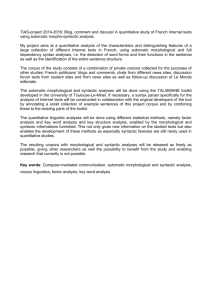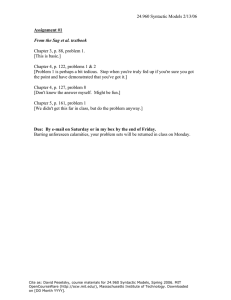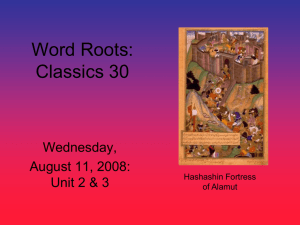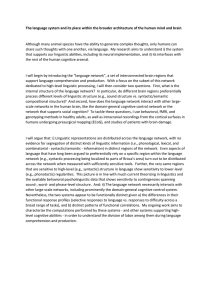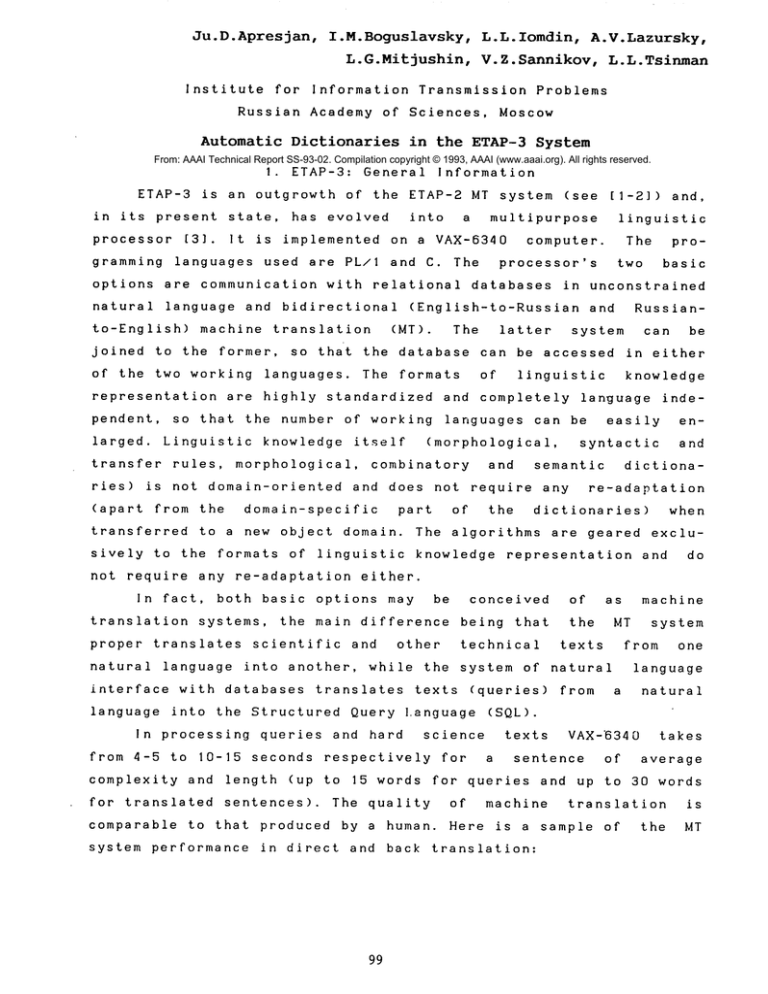
Ju.D.Apresjan,
I.M.Boguslavsky,
L.L.Iomdin,
L.G.Mitjushin,
Institute
for
{nformation
Russian
Academy
Automatic
V.Z.Sannikov,
Transmission
of
Sciences,
Dictionaries
in
A.V.Lazursky,
L.L.Tsinman
Problems
Moscow
the
ETAP-3
System
From: AAAI Technical Report SS-93-02. Compilation copyright © 1993, AAAI (www.aaai.org). All rights reserved.
|.
ETAP-3
in
its
is
an
present
processor
}t
are
natural
language
joined
the
the
two
so
that
Linguistic
transfer
rules,
is
(apart
not
not
the
{n
any
fact,
translation
proper
language
In
4-5
complexity
for
into
processing
queries
{0-{5
and
translated
comparable
system
to
(up
performance
does
system
can
accessed
completely
in
either
knowledge
language
can
be
inde-
easily
en-
syntactic
and
semantic
require
of
Russian-
linguistic
the
any
and
dictiona-
re-adaptation
dictionaries)
algorithms
knowledge
may
are
when
geared
exclu-
representation
be
being
and
technical
other
while
the
texts
hard
and
direct
{5
words
The
by
quality
a
and
human.
back
99
the
do
machine
MT
system
from
natural
(queries)
one
language
from
a
natural
(SQL).
for
for
as
texts
of
science
respectively
of
that
system
l anguage
and
to
conceived
difference
Query
produced
in
of
not
The
translates
sentences).
that
be
basic
either.
seconds
length
can
pro-
unconstrained
and
languages
part
another,
Structured
in
(morphological,
domain.
main
the
to
working
options
databases
The
two
latter
combinatory
scientific
with
into
the
The
and,
linguistic
computer.
databases
and
linguistic
basic
systems,
language
interface
from
both
[{-2])
processor’s
formats
itself
re-adaptation
translates
natural
of
and
of
The
database
standardized
object
formats
C.
(see
multipurpose
VAX-6340
(MT).
domain-specific
new
system
(English-to-Russian
The
number
a
relational
the
knowledge
a
a
and
morphological,
to
require
PL/|
that
highly
MT
into
on
with
so
the
the
transferred
to
are
domain-oriented
from
sively
evolved
languages.
are
ETAP-2
translation
working
|nformation
bidirectional
former,
larged.
ries)
used
and
representation
pendent,
has
the
implemented
machine
to
of
communication
to-English)
of
is
languages
options
General
outgrowth
state,
[3].
gramming
ETAP-3:
texts
a
sentence
queries
of
Here
and
machine
is
translation:
VAX-B340
a
takes
of
up
to
average
30
words
translation
sample
of
is
the
MT
In
recent
years,
processor
government
development
and
revolution
in
V nedavnie
gody
pravi
razvi
tie
bovanija,
chemical,
vyzvali
perevorot
rudovani
i
In
recent
of
microprocessors
chemical,
tel
and
a
set
system
is
in
of
the
natural
accounted
cient
MT
the
their
it
to
for
The
three
levels
are
morphological,
the
above,
age
interface
lism
is
set
with
dependency
In
what
tense,
mous
wordforms
Syntactic
and
and
of
text
repre-
representation
deep
and
in
Mel’chuk’s
a
in
This
difference
display
(=norma-
a
transition
there
natural
the
level
suffi-
syntactic
effect
is
a more
language
mismatch
of
the
in
and
suc~
semant’ics,
a
which
representation.
deep
level
shared
by
syntactic.
in
all
we
concentrate
the
As
system
both
is
of
systems
clear
natural
the
levels,
apart
are
written
in
on
representations
are
characteristics
assigned
alternative
deep
in
from
the
from
langu-
the
same
morforma-
trees.
follows
etc.)
levels
representation
At
obo-
revolution
from
However,
the
of
representations
morphological
aspect
text
databases.
sentence
of
of
of
of
overcome
reach
a semantic
Morphological
a
to
syntactic,
there
phological,
so
level
faktorov
development
a
languages
mismatch
queries
additional
caused
databases.
level
language.
to
demands,
of
natural
between
necessary
the
with
the
that
tre-
i promyshlennom
three
levels
the
with
drugix
inspiration
are
that
target
counterparts,
becomes
acounts
cope
the
its
interface
at
a
Background
four
fact
difference
SQL
pair
to
source
fundamental
the
forced
instrumentation
mnozhestvo
factors
There
and
similarity
structure
from
system
by
linguistic
lized)
[4].
have
equipment.
takes
language
for
other
micro-
texnicheskie
technical
Linguistic
theory
industrial
i
industrial
ETAP-3
influences
bioximicheskom
of
demands,
postanovlenija,
decrees,
and
Linguistically.
sentation
other
and
ximicheskom,
government
) Text"
of
"stvennye
2.
~
host
biochemical
biochemical
"Meaning
a
technical
mikroprocessorov
v
years
regulations,
syntactic
to
each
sets
of
the
strings
systems
of
only.
lexeme
(specifications
such
name.
In
case
characteristics
representations,
i00
MT
are
or
names,
with
of
number,
of
homony-
generated.
structures,
are
linearly
nodes
60
ordered
and
subordination
relations
specific
apart
dependency
are
aithough
ning
the
in
basic
to
the
account
process
of
adjacent
3.
Basic
for
Russian-to-English)
are
ievels
each
cannot
MT
grammar
be
MT
for
alI,
40
to
or
language
kept
strictiy
structures
combi-
avoided.
System
option
(i.e.
are
hybrid
of
(in
universal
the
transfer
levels
of
arcs
various
AII
of
representations
labeiIed
Components
components
wordform
for
constructions.)
eiements
Two
with
reiations
used
syntactic
trees,
(EngIish-to-Russian
sets
of
rules)
and
rules.
They
and
dictiona-
ries.
The
core
wordform
of
filters
and
other
tree
(or
a number
the
set
of
tic
structure
of
tic
structure
which
source
the
which
phase
are
called
number
of
motivated
ration
At
the
its
accomplished
stage
all,
the
are
of
case
the
level
of
units
of
the
obtained
syntactic
target
language.
elements,
structure
rules
of
MT
system
use
makes
dictionaries
monolingual
translation
rules
are
are
in
during
dependency
At
the
the
with
of
this
to
target
applied
next
a
semantically
result
the
the
structure
synthesis
of
syntac-
to
ope-
produce
language.
produce
the
orthography.
Dictionaries
combinatory
the
syntactic
deep
equipped
including
to
syntactic
is
and
(syntac-
place,
and
structure
depen-
specific
takes
a
homonymy)
syntactic
proper)
(lexical
units
deep
onto
tree
the
language-
of
system
syntactic
into
the
pair
correct
resulting
transformed
is
a
sentence
the
of
The
whatever
submitted
nearly
dictionaries
is
4.
and
in
map
sophisticated
extract
hypotheses.
conventional
guages)
two
trees
morphological
in
A
characteristics,
turn
processed
to
(translation
by
the
applied
such
specific
morphological
four
on
units
lingual
certain
is
replaced
sentence
which
free
expansion
in
last
In
is
morphological
fully
target
of
phase
language
is
the
It
in
subtree.
sentence)
structural
relations)
the
the
transfer
all
is
admissible
language.
parsing
dependency
devices
of
are
occurring
binary
out
that
system
representations
(hypothetical)
dency
the
the
MT
of
(for
four
dictionaries:
each
of
dictionaries
(except
in
the
addressed
in
i01
for
entries
both
System
the
two
for
Russian
the
translation
of
both
directions
two
mono-
working
lan-
and
English,
zone
dictionaries).
of
translation.
and
All
While
morphological
gical
analysis/synthesis
extensive
other
for
dictionaries
only,
information
properties
parsing
tionary
its
(2)
lexemes
specify
part
the
the
subsequent
entries
(I)
on
of
and
contain
of
the
combinatory
semantic,
to
all
provide
every
|n
for
morpholo-
dictionaries
syntactic,
transfer.
for
information
store
co-occurrence
the
material,
particular,
.and
necessary
combinatory
dic-
keyword
speech;
simplest
and
most
features
of
common
translation
into
the
target
language;
(3)
syntactic
precluding
total
its
number
English
occurrence
of
and
such
around
declare,
report,
"passto"
which
the
passive
made
to
marks
data),
its
the
(5)
its
potential
direct
NP
to
system
such
occur
the
to
the
is
150
verbs
assigned
govern
reported
for
as
the
say,
feature
to-infinitive
have
it
a year
Apart
a
failed
the
form
in
or
He
was
be
the
case
given
dictionary
are
expected
with
funny
keyword
for
of
50
occurs
must
a
the
must
be
further
for
the
which
it
form
from
a
how
its
the
may
govern
somebody
’person’
much
and
semantic
from
of
80;
that
be
the
example,
’money’.
house
entry
rules
in
which
attention
for
and
or
with
a
an
fur-
duration
specification
his
neighbour
for
references
to
dollars.
scope)
rules
form
rented
dictionary
lexical
dictionary
entry
a
He
in
the
over
requirements
indication
it
with
colour),
meet;
that
it
long
cf.
price
that,
in
that
how
to
sign,
indications
semantic
the
picture,
is
further
phrase
phrase"
’time’;
from
(narrow
so-called
or
’action’
text,
features
lexical
as
pressure,
with
specification
for
(for
semantic
a counteragent
"price
such
length,
pattern,
specification
specific
the
such
supplied
semantic
must
for
be
object,
semantic
in
of
dependents
will
(desrciptors),
velocity,
number
’institution’,
that
to
are
’information’
government
further
phrase
(for
actant
rent
ther
is
the
example,
etc.
it
constructions;
in
for
ability
features
syntactic,
to
with
syntactic
feel
He
walk),
total
morphological,
a
their
semantic
’parameter’
verb
Russian;
in
allowing
operational
help,
aa
production,
like:
for
make,
voice,
certain
features
200
keyword
stay;
(4)
work,
in
the
will
102
which
the
are
may
contain
should
processed
be
sentence,
word-specific.
contain
ac%ivated
reference
For
and
example,
to
the
the
the
speci-
fic
transfer
phrases
4
rule
like
to
privlekat"
manie
ted
a
lation
into
so
of
in
on.
all
way
the
a thousand)
4
whose
from
rules
may
will
be
one
(whose
to
mentioned
the
draw
in
support
the
verbs
in
number
all
to
of
in
the
vni-
dictionary
are
their
the
attention
sosredotochivat’
indicated
total
pertain
4
context
the
translation
vnimanie,
attention
rule
in
idiomatic
udeljat"
focus
same
nouns
the
transla-
common
system
trans-
goes
non-morphological
well
phases
of
processing.
The
ary
to
The
Such
for
attention
different
zone.
sentence
extent
entries
either
of
a
of
sophistication
makes
procedure
al
pay
vnimanie,
and
entries
providing
of
dictionaries,
extensively
ry.
Besides
for
large
virtually
compiling
corpus
are
it
impossible
combinatory
examples
or
although
used
that,
necessary
to
lexicographic
to
devise
man-made
corpus
and
the
automatic
produce
prototypical
compile
dictionary
from
the
to
classes
to
any
dictionautomatic
entries
directly
monolingual
or
the
dictionary
such
"human"
bilingu-
dictionaries
combinatory
entries
from
dictiona-
can
be
facilitate
the
for
inflected
selected
actual
work’
of
compilation.
Even
such
as
morphological
Russian
though
of
this
would
course
work.
entries
helps
in
can
uses
system,
allow
a
be
special
which
the
entries
case
helps
to
to
the
whole
may
compilation,
based
as
a
simple
morphological
system,
a
many
dialogue
Russian
250
ques-
diction-
short
of
as
al-
facilitate
on
paradigms
contain
languages
substantially
produce
In
verbs,
automatic
algorithm
generating
of
highly
fully
devised
semi-automatically.
create
which,
hardly
means
ETAP-3
tion-answering
ary
dictionaries
words
wordforms.
References
I.
Ju.D.
ETAP-2.
2.
Ju.D.
lation
3.
Apresjan
(The
al.
Linguistics
Apresjan
System,
et
META,
al.
1992,
informacionnyx
sistem.
(A
tion
Moskva:
systems.)
|.A.
Tekst.
Moskva:
Mel’chuk.
(The
Nauka,
vol.
The
37,
system.)
Linguistics
1,
No
linguistic
pp.
Moskva:
of
a
Naula,
Machine
|g8g.
Trans
97-112.
processor
processor
sistemy
for
dlja
slozhnyx
advanced
informa-
|ggs.
teorii
of
ETAP-2
obespechenie
Lingvisticheskij
Nauka,
Opyt
theory
the
ETAP-a:
al.
H
Apresjan
Lingvisticheskoe
of
et
4.
Ju.D.
et
lingvisticheskix
Meaning
~
1974.
103
)
Text
type
modelej
linguistic
tipa
"Smysl
models.)


